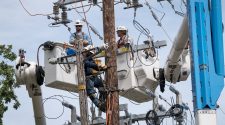A bipartisan bill making its way through Congress could be a major step forward to expand modern border security technology to help streamline commerce, safeguard intellectual property and derail criminals along the Southwest border.
Expanding technology like autonomous towers, ground sensors, electro-optical cameras, lasers, chemical detectors, X-rays and other devices would aid U.S. Customs and Border Protection (CBP) in carrying out its two-fold mission: to facilitate trade and protect national security, proponents of the bill said.
“Our bipartisan bill improves border security technology to help strengthen security and keep Arizona safe,” said Arizona Sen. Kyrsten Sinema, who introduced the bill in the Senate along with Texas Senator John Cornyn (R).
Continuing to modernize technology along the heavily trafficked border is particularly important for Arizona, which relies heavily on trade and supply chains with Mexico, said Glenn Hamer, president and CEO of the Arizona Chamber of Commerce and Industry.
“The trade flows between Arizona and Sonora and the rest of Mexico are central to the state’s overall economic health,” Hamer said. “Data reveals that Arizona trade with Mexico in 2018 was over $16 billion, a 7.7% increase from the previous year.”
Bill would assess technology gaps “mile-by-mile”
The bill, the Southwest Border Security Technology Improvement Act of 2020, would require the Department of Homeland Security (DHS) to assess the technology needs along every mile of the 2,000 mile border in conjunction with physical barriers.
Under the legislation, Homeland Security would take a more detailed look at emerging technologies, including manned and unmanned aerial systems, tower-based surveillance technology, and tunnel and other detection devices. DHS also would be required to consider and examine the impact of public health emergencies like the coronavirus on border security.
The analysis would help the agency strengthen terrorist prevention, reduce criminal activity and explore new technologies, the co-sponsors said.
DHS would be required to report back on areas where improvements could be made. A border security technology plan then would be developed to procure or develop identified technologies.
The bill recently cleared the Senate Homeland Security and Governmental Affairs Committee and now is on its way to the full Senate. A mirror version of the bill was introduced in the House last week by Rep. Xochitl Torres Small (D-N.M.) and Rep. Dan Crenshaw (R-Texas).
Among those in support of the bill are the Border Trade Alliance, the Border Patrol Council and the National Treasury Employees Union, which represents the nation’s CBP officers and trade enforcement specialists.
U.S. investing in unmanned towers, sensors, imaging technologies
Over the past few years, border agencies have been investing more in emerging commercial technologies for more efficient operations and capabilities.
In the past two years, Homeland Security has been investing in autonomous surveillance towers, formerly known as Innovative Towers, that operate off-grid with 100 percent renewable energy and provide autonomous surveillance operations 24 hours per day. CBP recently entered into a contract with “virtual border wall” startup Anduril for over 140 unmanned surveillance towers to put in place in 2021 and 2022.
The agency also is testing non-intrusive inspection technology at ports of entry that will allow CBP personnel to see an image inside commercial trucks at a border crossing before drivers pull up for inspection. The technology would make it easier for officers to make faster and better informed decisions about which cargo trucks to stop for more thorough inspections.
To read the bill in its entirety, go to: Southwest Border Security Technology Improvement Act.
This story was originally published at Chamber Business News.
















